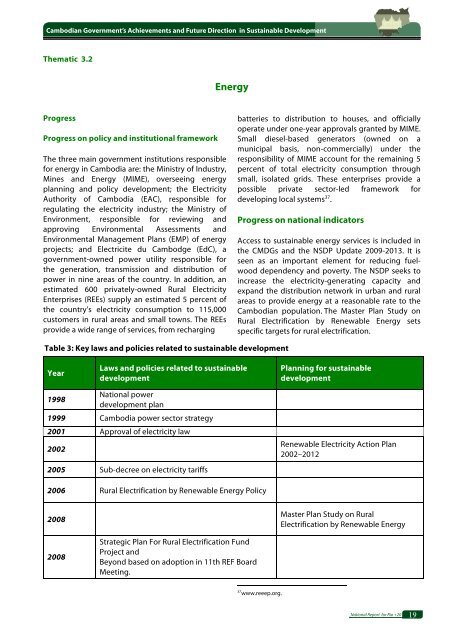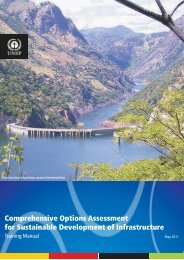National Report - Cambodia - United Nations Sustainable ...
National Report - Cambodia - United Nations Sustainable ...
National Report - Cambodia - United Nations Sustainable ...
Create successful ePaper yourself
Turn your PDF publications into a flip-book with our unique Google optimized e-Paper software.
<strong>Cambodia</strong>n Government’s Achievements and Future Direction in <strong>Sustainable</strong> Development<br />
Thematic 3.2<br />
Energy<br />
Progress<br />
Progress on policy and institutional framework<br />
The three main government institutions responsible<br />
for energy in <strong>Cambodia</strong> are: the Ministry of Industry,<br />
Mines and Energy (MIME), overseeing energy<br />
planning and policy development; the Electricity<br />
Authority of <strong>Cambodia</strong> (EAC), responsible for<br />
regulating the electricity industry; the Ministry of<br />
Environment, responsible for reviewing and<br />
approving Environmental Assessments and<br />
Environmental Management Plans (EMP) of energy<br />
projects; and Electricite du Cambodge (EdC), a<br />
government-owned power utility responsible for<br />
the generation, transmission and distribution of<br />
power in nine areas of the country. In addition, an<br />
estimated 600 privately-owned Rural Electricity<br />
Enterprises (REEs) supply an estimated 5 percent of<br />
the country’s electricity consumption to 115,000<br />
customers in rural areas and small towns. The REEs<br />
provide a wide range of services, from recharging<br />
batteries to distribution to houses, and officially<br />
operate under one-year approvals granted by MIME.<br />
Small diesel-based generators (owned on a<br />
municipal basis, non-commercially) under the<br />
responsibility of MIME account for the remaining 5<br />
percent of total electricity consumption through<br />
small, isolated grids. These enterprises provide a<br />
possible private sector-led framework for<br />
developing local systems 37 .<br />
Progress on national indicators<br />
Access to sustainable energy services is included in<br />
the CMDGs and the NSDP Update 2009-2013. It is<br />
seen as an important element for reducing fuelwood<br />
dependency and poverty. The NSDP seeks to<br />
increase the electricity-generating capacity and<br />
expand the distribution network in urban and rural<br />
areas to provide energy at a reasonable rate to the<br />
<strong>Cambodia</strong>n population. The Master Plan Study on<br />
Rural Electrification by Renewable Energy sets<br />
specific targets for rural electrification.<br />
Table 3: Key laws and policies related to sustainable development <br />
Year<br />
Laws and policies related to sustainable<br />
development<br />
Planning for sustainable<br />
development<br />
1998<br />
<strong>National</strong> power<br />
development plan<br />
1999 <strong>Cambodia</strong> power sector strategy<br />
2001 Approval of electricity law<br />
2002<br />
2005 Sub-decree on electricity tariffs<br />
Renewable Electricity Action Plan<br />
2002–2012<br />
2006 Rural Electrification by Renewable Energy Policy<br />
2008<br />
Master Plan Study on Rural<br />
Electrification by Renewable Energy<br />
2008<br />
Strategic Plan For Rural Electrification Fund<br />
Project and<br />
Beyond based on adoption in 11th REF Board<br />
Meeting.<br />
37<br />
www.reeep.org.<br />
<strong>National</strong> <strong>Report</strong> for Rio +20 19
















